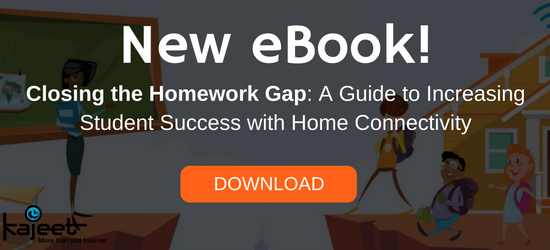How OER Can Help Low-Income School Districts
Written by:
Kajeet

Could three simple letters change the face of education in low-income school districts?
That’s the hope for OER, or open educational resources, which can allow school districts – especially ones struggling to keep pace with changing state and federal standards in education – to bridge the wide gap in 21st-century education.
OER: DEMOCRATIZING EDUCATION
As we noted last year, OER offers a new model of learning structured as a digital ecosystem every student can access. The idea is that students, in whatever district, at whatever school, can use public digital resources whose licenses allow for both the free use of materials – like complete online courses, digital textbooks, educational videos, and assessment tools – and the ability to share them between classrooms and schools.
What makes OER so game-changing is not only its dependence on the Internet but its democratic approach to K-12 education. OER can:
- Bring students together who might otherwise not collaborate,
- Help school districts spend smarter and more effectively,
- Enhance students’ digital literacy skills, and
- Allow teachers a greater freedom in what they teach – and how.
A HIGH PRIORITY FOR K-12 IT LEADERS
More and more, OER is becoming a priority for school districts across the country. According to a 2017 report from the Consortium for School Networking (CoSN), 79 percent of K-12 IT leaders surveyed said that OER was part of their district’s digital content strategy.
The rise in OER prioritization is linked to the federal government’s 2015 #GoOpen initiative, designed to emphasize the use of OER in American classrooms.
According to the U.S. Department of Education’s Office of Educational Technology, the idea behind the #GoOpen initiative is the democratization of learning.
'We believe that educational opportunities should be available to all learners. Creating an open education ecosystem involves making learning materials, data, and educational opportunities available without restrictions imposed by copyright laws, access barriers, or exclusive proprietary systems that lack interoperability and limit the free exchange of information.'
And yet, despite the emphasis on access to all, the truth remains that many low-income school districts have a hard time accessing the educational technology that’s driving how students learn today.
NO DISTRICT LEFT BEHIND
A commentary piece in Education Week by Lisa Petrides of the Institute for the Study of Knowledge Management in Education and Barbara Dezmon of Maryland’s NAACP state executive committee discusses a 2015 report that revealed the highest-poverty public school districts in the nation received about $1,200 less in state and local funding per student.
This lack of resources and budgets is also linked to racial demographics. As The Atlantic reports, in around half of the 100 largest cities in the United States, most African-American and Latino students go to public schools where at least 75 percent of all students are low-income.
But that doesn’t mean these school districts have to remain behind.
Both the NAACP and the Institute for the Study of Knowledge Management in Education are collaborating to enact key policy changes to help less-affluent school districts provide their students with quality, up-to-date OER materials aligned with today’s demanding standards.
How to expand the democratization of educational tools, resources, and curricula through OER? Both organizations, according to Education Week, have devised several key efforts to close the achievement gap.
- Organize: Education is a civil rights issue, so it’s essential to craft a broad coalition that includes everyone from policy makers to teachers to the heads of parent organizations.
- Learn: By learning from existing OER users, districts with a high percentage of low-income students can tailor their approach to OER programs in ways that best align with success stories and state standards.
- Invest: Time and energy should be put into educating teachers, librarians, and IT leaders on how OER works, thereby encouraging its adoption at a mass scale.
- Support. Because there’s little support out there for some districts to help educators access and use OER, tech support and training for staff and administrators is critical.
“Until we level the playing field with a realistic plan to provide learning resources at scale,” Petrides and Dezmon write, “a quality education will remain another unfulfilled promise for the students who need it the most.”
OER SUCCESS STARTS WITH INTERNET ACCESS
For districts with a high percentage of low-income students that plan on tapping into the power of OER, there’s one other thing that’s critical: 24/7 high-speed Internet access.
Students using OER need to have the Internet not just at school but outside the classroom where they may not have immediate access to reliable, safe, broadband Internet. The root of OER is in the digital sphere, which means that in order for school districts – of whatever size and budget – to benefit from it, students need to be able to access these digital resources wherever and whenever necessary.
One affordable solution is the Kajeet SmartSpot®, a mobile hotspot that makes it easy for today’s mobile students to stay connected to the digital resources and information they need to learn. Education-only, CIPA-compliant filters ensure student safety, while reliable Internet provides the connectivity they need to access OER at home or on the go.
In order for open access to educational resources to be successful, students need equal access to the Internet, whether in the classroom, on the school bus, at home, or anywhere in between.


